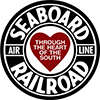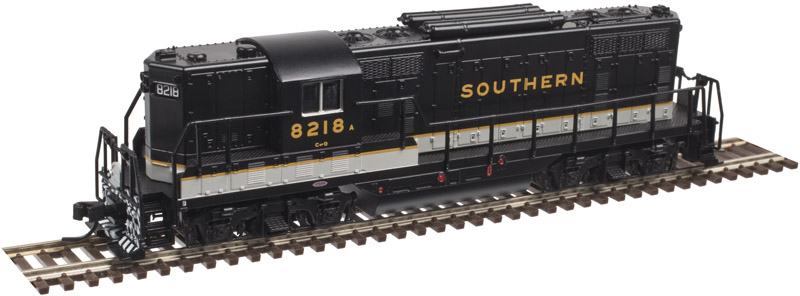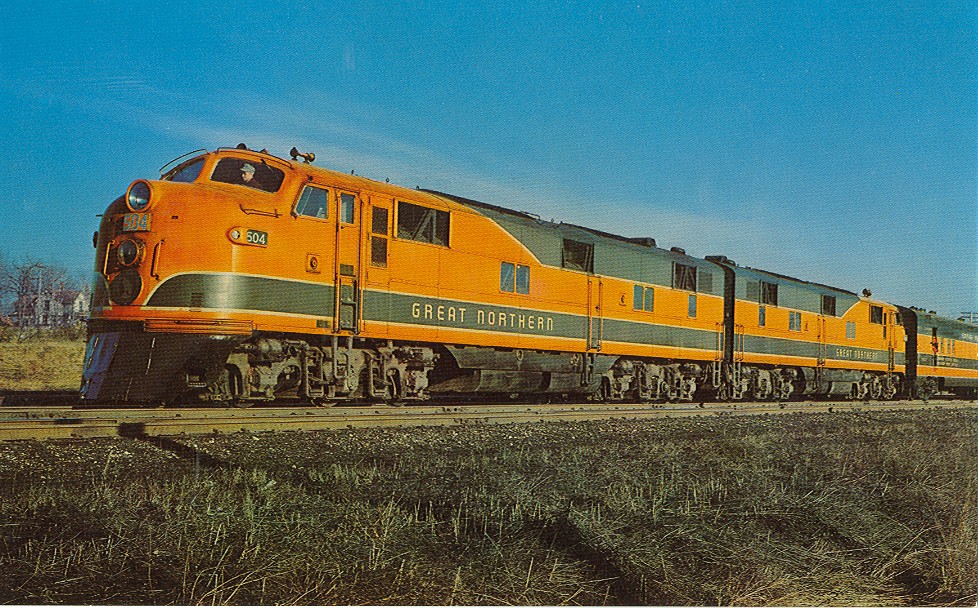Specific Item Information: Road Numbers: 3021 & 3105
Prototype History: The E7 was a 2,000-horsepower (1,500 kW), A1A-A1A passenger train locomotive built by General Motors' Electro-Motive Division of La Grange, Illinois. 428 cab versions, or E7As, were built from February 1945 to April 1949; 82 booster E7Bs were built from March 1945 to July 1948. (Circa 1953 one more E7A was built by the Los Angeles General Shops of the Southern Pacific by rebuilding an E2A.) The 2,000 hp came from two 12 cylinder model 567A engines. Each engine drove its own electrical generator to power the two traction motors on one truck. The E7 was the eighth model in a line of passenger diesels of similar design known as EMD E-units.
In profile the front of the nose of an E7A was less slanted than on earlier EMD passenger locomotives, and the E7, E8, and E9 units have been nicknamed “bulldog nose” units. Some earlier units were called “shovel nose” units or “slant nose” units.
From Wikipedia
Read more on American-Rails.com
In profile the front of the nose of an E7A was less slanted than on earlier EMD passenger locomotives, and the E7, E8, and E9 units have been nicknamed “bulldog nose” units. Some earlier units were called “shovel nose” units or “slant nose” units.
From Wikipedia
Read more on American-Rails.com
Road Name History: The Seaboard Air Line Railroad (reporting mark SAL), which styled itself "The Route of Courteous Service," was an American railroad whose corporate existence extended from April 14, 1900 until July 1, 1967, when it merged with the Atlantic Coast Line Railroad, its longtime rival, to form the Seaboard Coast Line Railroad. The company was headquartered in Norfolk, Virginia, until 1958, when its main offices were relocated to Richmond, Virginia. The Seaboard Air Line Railway Building in Norfolk's historic Freemason District still stands and has been converted to luxury apartments.
At the end of 1925 SAL operated 3,929 miles of road, not including its flock of subsidiaries; at the end of 1960 it reported 4,135 miles. The main line ran from Richmond via Raleigh, North Carolina, Columbia, South Carolina, and Savannah, Georgia to Jacksonville, Florida, a major interchange point for passenger trains bringing travelers to the Sunshine State. From Jacksonville, Seaboard rails continued to Tampa, St. Petersburg, West Palm Beach and Miami.
Other important Seaboard routes included a line from Jacksonville via Tallahassee to a connection with the L&N at Chattahoochee, Florida, for through service to New Orleans; a line to Atlanta, Georgia, and Birmingham, Alabama, connecting with the main line at Hamlet, North Carolina; and a line from the main at Norlina, North Carolina, to Portsmouth, Virginia, the earliest route of what became the Seaboard.
In the first half of the 20th century Seaboard, along with its main competitors Atlantic Coast Line Railroad, Florida East Coast Railway and Southern Railway, contributed greatly to the economic development of the Southeastern United States, and particularly to that of Florida. Its brought vacationers to Florida from the Northeast and carried southern timber, minerals and produce, especially Florida citrus crops, to the northern states.
Wikipedia.
At the end of 1925 SAL operated 3,929 miles of road, not including its flock of subsidiaries; at the end of 1960 it reported 4,135 miles. The main line ran from Richmond via Raleigh, North Carolina, Columbia, South Carolina, and Savannah, Georgia to Jacksonville, Florida, a major interchange point for passenger trains bringing travelers to the Sunshine State. From Jacksonville, Seaboard rails continued to Tampa, St. Petersburg, West Palm Beach and Miami.
Other important Seaboard routes included a line from Jacksonville via Tallahassee to a connection with the L&N at Chattahoochee, Florida, for through service to New Orleans; a line to Atlanta, Georgia, and Birmingham, Alabama, connecting with the main line at Hamlet, North Carolina; and a line from the main at Norlina, North Carolina, to Portsmouth, Virginia, the earliest route of what became the Seaboard.
In the first half of the 20th century Seaboard, along with its main competitors Atlantic Coast Line Railroad, Florida East Coast Railway and Southern Railway, contributed greatly to the economic development of the Southeastern United States, and particularly to that of Florida. Its brought vacationers to Florida from the Northeast and carried southern timber, minerals and produce, especially Florida citrus crops, to the northern states.
Wikipedia.
Brand/Importer Information: AZL is the leader in North American Z scale locomotives and rolling stock. Since 2000, AZL has released a vast variety of freight, passenger and locomotives. AZL continues to push the boundaries of Z scale with amazing details and incredible performance. No matter if you are looking to run steam, or the most modern diesels, AZL has something for you.
Item created by: CNW400 on 2021-07-08 21:50:03. Last edited by CNW400 on 2021-07-08 21:51:17
If you see errors or missing data in this entry, please feel free to log in and edit it. Anyone with a Gmail account can log in instantly.
If you see errors or missing data in this entry, please feel free to log in and edit it. Anyone with a Gmail account can log in instantly.









